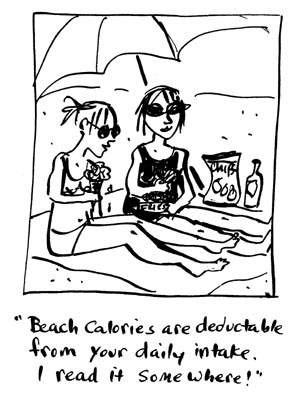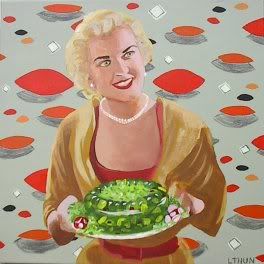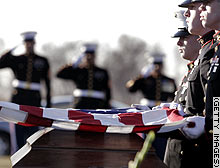The World Says Goodbye To A Hero Today

KENNETT SQUARE, Pa. (AP) --
His passing, upon further review, is immeasurable.
Kentucky Derby winner Barbaro was euthanized Monday after complications from his gruesome breakdown at last year's Preakness, ending an eight-month ordeal that prompted an outpouring of support across the country.
A series of ailments -- including laminitis in the left rear hoof, an abscess in the right rear hoof, as well as new laminitis in both front feet -- proved too much for the gallant colt. The horse was put down at 10:30 a.m.
"Certainly, grief is the price we all pay for love," said co-owner Gretchen Jackson at a news conference.
Barbaro battled in his ICU stall for eight months. The 4-year-old colt underwent several procedures and was fitted with fiberglass casts. He spent time in a sling to ease pressure on his legs, had pins inserted and was fitted at the end with an external brace. These were all extraordinary measures for a horse with such injuries.
"Clearly, this was a difficult decision to make," chief surgeon Dr. Dean Richardson. "It hinged on what we said all along, whether or not we thought his quality of life was acceptable. The probable outcome was just so poor."
Richardson, fighting back tears, added: "Barbaro had many, many good days."
Roy and Gretchen Jackson were with Barbaro on Monday morning, with the owners making the decision in consultation with Richardson.
"We just reached a point where it was going to be difficult for him to go on without pain," Roy Jackson said. "It was the right decision, it was the right thing to do. We said all along if there was a situation where it would become more difficult for him then it would be time."
Richardson said he was comfortable the right decision was made and could tell Barbaro was not his usual self early Monday morning.
"He was just a different horse," he said. "You could see he was upset. That was the difference. It was more than we wanted to put him through."
On May 20, Barbaro was rushed to the New Bolton Center, about 30 miles from Philadelphia in Kennett Square, hours after shattering his right hind leg just a few strides into the Preakness Stakes. The bay colt underwent a five-hour operation that fused two joints, recovering from an injury most horses never survive.
"It'd be nice if he's remembered for winning the Kentucky Derby, not for breaking down in the Preakness," said Peter Brette, Barbaro's exercise rider and assistant trainer for Michael Matz.
Barbaro suffered a significant setback over the weekend, and surgery was required to insert two steel pins in a bone -- one of three shattered in the Preakness but now healthy -- to eliminate all weight bearing on the ailing right rear foot.
The leg was on the mend until an abscess began causing discomfort last week. Until then, the major concern was Barbaro's left rear leg, where 80 percent of the hoof had been removed in July when he developed laminitis.
"This horse was a hero," said David Switzer, executive director of the Kentucky Thoroughbred Association. "His owners went above and beyond the call of duty to save this horse. It's an unfortunate situation, but I think they did the right thing in putting him down."
Brilliant on the race track, Barbaro always will be remembered for his brave fight for survival.
When Barbaro broke down, his right hind leg flared out awkwardly as jockey Edgar Prado jumped off and tried to steady the ailing horse. Race fans at Pimlico wept. Within 24 hours the entire nation seemed to be caught up in a "Barbaro watch."
Well-wishers young and old showed up at the New Bolton Center with cards, flowers, gifts, goodies and even religious medals for the champ, and thousands of e-mails poured into the hospital's Web site just for him.
The biggest gift has been the $1.2 million raised since early June for the Barbaro Fund. The money is put toward needed equipment such as an operating room table, and a raft and sling for the same pool recovery Barbaro used after his surgeries.
"I would say thank you for everything, and all your thoughts and prayers over the last eight months or so," Roy Jackson said to Barbaro's fans.
The Jacksons spent tens of thousands of dollars hoping the best horse they ever owned would recover and be able to live a comfortable life on the farm. The couple, who own about 70 racehorses, broodmares and yearlings, and operate the 190-acre Lael Farm, have been in the horse business for 30 years, and never had a horse like Barbaro.
Foaled and raised at Sanborn Chase at Springmint Farm near Nicholasville, Ky., breeder Bill Sanborn fought back tears Monday as he talked about "the privilege" of working with the colt.
"Everything was looking really, really good, and of course I honestly thought that the horse was going to pull it off," he said. "It just wasn't meant to be. It didn't surprise me that he fought so long. He was a great horse."
Dr. Larry Bramlage, a veterinarian at Rood and Riddle Equine Hospital in Lexington, said the horse lived as long as he did because of Richardson's solid decision-making.
"It's kind of like playing a chess game," Bramlage said. "Whenever you get confronted with something different, you have to make the right moves. You have to be impressed with the number of right moves Dr. Richardson made. They got close, and if not for a little bad luck they would have made it."
La Ville Rouge, Barbaro's broodmare, remains pregnant at Mills Ridge Farm in Lexington with a full brother to Barbaro. The foal is expected to be born sometime in the early spring, according to farm spokesperson Kimberly Poulin.
A son of Dynaformer, out of the dam La Ville Rouge, Barbaro started his career on the turf, but Matz knew he would have to try his versatile colt on the dirt. He reasoned that if he had a talented 3-year-old in America, he'd have to find out early if his horse was good enough for the Triple Crown races.
Barbaro was good enough, all right. He won his first three races on turf with authority, including the Laurel Futurity by eight lengths and the Tropical Park Derby by 33/4 lengths.
That's when Matz drew up an unconventional plan for a dirt campaign that spaced out Barbaro's race to keep him fit for the entire Triple Crown, a grueling ordeal of three races in five weeks at varying distances over different tracks.
Barbaro won the Holy Bull Stakes at Gulfstream Park on Feb. 4, but his dirt debut was inconclusive since it came over a sloppy track. After an eight-week break, an unusually long time between races, Barbaro came back and won the Florida Derby by a half-length over Sharp Humor.
The deal was sealed -- on to the Derby, but not without criticism that Barbaro couldn't win coming off a five-week layoff. After all, it had been 50 years since Needles won the Derby off a similar break. But Matz stuck to his plan.
Not only did Barbaro win the Derby, he demolished what was supposed to be one of the toughest fields in years. The 61/2-length winning margin was the largest since 1946, when Assault won by eight lengths and went on to sweep the Triple Crown.
In Barbaro, Matz truly believed he was training a Triple Crown winner. He often said Barbaro was good enough to be ranked among the greats and join Seattle Slew as the only unbeaten Triple Crown champions.
But two weeks later after the Derby Barbaro took a horrible misstep and one of the most extraordinary attempts to save a thoroughbred was under way.
The injury was considered to be so disastrous that many thought the horse would be euthanized while still at Pimlico Race Track. Instead, Barbaro, who earned $2,302,200 with his six wins in seven starts, was operated on the next day by Richardson.
Though Barbaro endured the complicated five-hour surgery, Richardson called chances for a full recovery a "coin toss."
Afterward, though, things went relatively smoothly. Each day brought more optimism: Barbaro was eyeing the mares, nickering, gobbling up his feed and trying to walk out of his stall. But by mid-July, Richardson's greatest fear became reality -- laminitis struck Barbaro's left hind leg.
Barbaro responded well to treatment, but he began to struggle in January with a serious laminitis setback and this final, fatal turn.




























